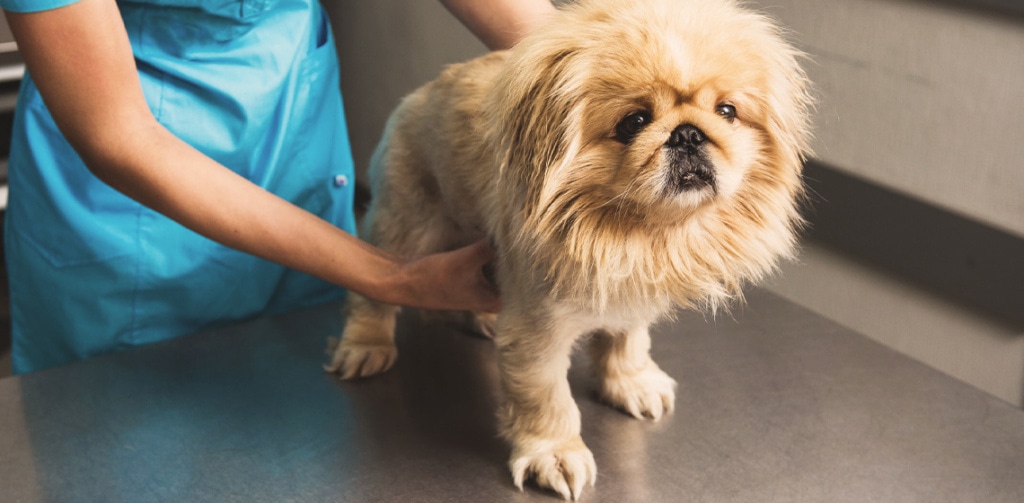If you’re a dog parent, you’ll want your dog to be in their best health possible. You might even spend time giving them a regular once-over – checking their hair for matts and their ears for wax and making sure that their nails are not too long. But there’s one part of a dog’s body that is often avoided by owners when it comes to checking for health issues, and that’s a dog’s penis. So, what health conditions can affect your dog’s penis? What symptoms should you look for, and when do you need to see a veterinarian?
Table of Contents
What should you look for when checking your dog’s penis?
It’s totally understandable to avoid giving your dog’s penis a quick health check. After all, it’s a private area and not the most pleasant. However, your dog’s penis can become affected by health conditions. Avoiding the area could mean that a problem becomes more serious because it hasn’t been treated quickly. So, it’s a good idea to make an effort to do a quick check reasonably regularly and not ignore any potentially concerning signs. The most important things to look out for are a foul smell, lots of discharge, soreness, or swelling. Alongside this, it’s worth watching for any signs that your dog’s penis is bothering them.
What is normal?
Because it’s not an area people look at regularly, it’s easy to confuse normal with abnormal. It’s common for dog parents to suddenly spot something about their dog’s penis that they haven’t noticed before and assume something is wrong. That’s why it’s so important to know what’s normal and nothing to worry about.
Smegma
A normal dog penis will produce smegma. Smegma is a mucousy material that protects the penis by keeping it moist and trapping any germs or debris. It can look green or yellow, and it can be very visible in some dogs. Smegma is odorless, and sometimes the amount that your dog produces can fluctuate.
Smell
A normal, healthy penis shouldn’t have a noticeable or unpleasant smell.
If there’s a foul-smelling odor coming from your dog’s penis, this could be a sign of balanitis, which is an infection of the penis and prepuce.
Color
A dog’s penis sits inside a haired sheath called the prepuce. The penis itself tends to vary in color from pale pink to bright red. If they are particularly excited, the penis becomes redder in color and can pop out, which leads some pet parents to refer to it as a ‘lipstick.’
Grooming
Aside from normal grooming habits, your dog shouldn’t pay much attention to their penis.
Position
In a healthy dog, the penis should be enclosed within the prepuce. However, when a dog becomes excited, especially when humping toys or other objects, their penis may protrude outside the prepuce. Once they become less excited, it should quickly return to a more normal position.
What signs could mean that your dog has a problem with their penis?
So, now that you know what normal is, what about abnormal? One of the main rules is, if it’s suddenly changed, then it’s best to get them checked by a veterinarian. Of course, once you start routinely giving your dog a head-to-toe check over, you’ll be better at noticing any changes. There are a few specific things you should out for, though.
Smell
If there’s a foul-smelling odor coming from your dog’s penis, this could be a sign of balanitis, which is an infection of the penis and prepuce.
Discharge
Although smegma is very normal, if your dog suddenly starts to produce large amounts of discharge, this could be a cause for concern. This is especially true if there is any blood within the discharge or it has an unpleasant smell.
Color
If your dog’s penis looks red or sore when not excited, this could also be a sign of balanitis. On the other hand, if the penis is protruding and starts to look a bit purple or even black, it might be a sign of paraphimosis. This is where the penis becomes swollen due to excitement and doesn’t fit back within the prepuce.
Licking, irritation, or excessive grooming
If your pooch starts paying extra attention to their penis by licking it excessively, this could be a sign that it is causing them pain or irritation. These signs could be caused by infection or by paraphimosis.
Paraphimosis can cause your dog pain and stop the blood flow, which can lead to cell death.
Position
If your dog’s penis is swollen and protruding from the prepuce and fails to return to its normal position within a few minutes after the excitement has ended, this could mean that they are experiencing paraphimosis.
When should you see a vet?
If you notice any changes in the appearance of your dog’s penis that aren’t associated with sexual excitement, you should contact a veterinarian. If you suspect your dog is suffering from paraphimosis, they may require urgent treatment. This is because once the penis becomes too large to return into the prepuce, the blood supply can also be affected. This becomes a vicious cycle as the prepuce becomes tighter and tighter and the penis more swollen. Not only is this very painful for your dog, but it can cause the tissues within the penis to die.
What are the treatment options?
Balanitis
If your veterinarian suspects that your dog has balanitis (a penis infection), they may require a course of antibiotic treatment and some anti-inflammatories. Your veterinarian might also suggest using a cone collar or item of clothing to stop your uncomfortable pup from licking the area and causing more irritation.
Paraphimosis
If your veterinarian diagnoses paraphimosis, they’ll need to act quickly to try to reduce the swelling and replace your dog’s penis into the prepuce. This can sometimes be done using a combination of lubricant and sugar solution to draw fluid out of the penis by osmosis. Because the condition can be painful, your dog might need some sedation or an anesthetic. Occasionally, a veterinarian will need to make a small incision into the prepuce to enlarge its opening so that the penis can be replaced and the blood supply restored.
So, how can you tell whether you need to be concerned about your dog’s penis?
Once you know what’s normal for your dog, you only need to watch out for any changes. The most important changes to spot are signs of pain or irritation, a foul odor, or swelling. With you keeping a close eye, you can be sure that no potential health concerns are lingering where you don’t look!
FAQ
If your dog has some smegma around their penis, but it is within the prepuce and not causing them any bother, it’s likely to be healthy. However, if you notice a sudden change in your dog’s penis, it’s worth speaking to a veterinarian.
It’s normal for your dog’s penis to swell and protrude from the prepuce, usually at times of excitement. In paraphimosis, the prepuce forms a tight band around the base of the penis so that it cannot return to its normal position. This can cause your dog pain and stop the blood flow, which can lead to cell death.

Dr. Hannah Godfrey MRCVS graduated from the Royal Veterinary College in 2011. Although she initially worked in mixed practice treating all species, she found a love for small animal work and has worked exclusively with dogs and cats since 2014. She lives in Wales with her partner, son, and two cats (named Poppy and Ashton Kutcher), and writes comedy fiction in her spare time.








